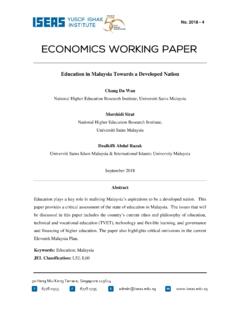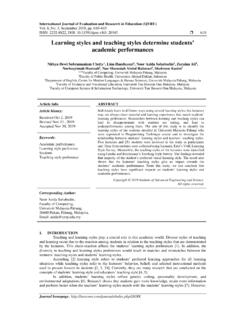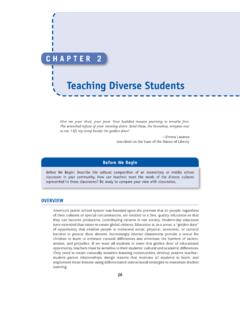Transcription of RESEARCH METHODOLOGY - Universiti Teknologi Malaysia
1 By DR. NORZAIDA ABAS RESEARCH METHODOLOGY METHODOLOGY -- 1 oResearch is the systematic approach to obtaining and confirming new and reliable knowledge oSystematic and orderly (following a series of steps) oPurpose is new knowledge, which must be reliable oThis is a general definition which applies to all disciplines What is RESEARCH METHODOLOGY ? METHODOLOGY -- 2 Data Collection an intermediate step to gain reliable knowledge collecting reliable data is part of the RESEARCH process Searching out published RESEARCH results in libraries (or the internet) This is an important early step of RESEARCH The RESEARCH process always includes synthesis and analysis But, just reviewing of literature is not RESEARCH RESEARCH is METHODOLOGY -- 3 4 for explanation of events, phenomena, relationships and causes What, how and why things occur Are there interactions?
2 Process Planned and managed to make the information generated credible The process is creative It is circular always leads to more questions RESEARCH METHODOLOGY -- 5 All well designed and conducted RESEARCH has potential application. Failure to see applications can be due to: Users not trained or experienced in the specialized methods of economic RESEARCH and reasoning Researchers often do not provide adequate interpretations and guidance on applications of the RESEARCH Researchers are responsible to help users understand RESEARCH implications (How?) METHODOLOGY -- Structure of RESEARCH begin with broad questions narrow down, focus in operationalize OBSERVE analyze data reach conclusions generalize back to questions The "hourglass" notion of RESEARCH METHODOLOGY -- 6 7 METHODOLOGY and Method are often (incorrectly) used interchangeable METHODOLOGY the study of the general approach to inquiry in a given field Method the specific techniques, tools or procedures applied to achieve a given objective RESEARCH methods in economics include regression analysis, mathematical analysis, operations RESEARCH , surveys, data gathering, etc.
3 METHODOLOGY Defined & Described METHODOLOGY -- oMethodology is the core of your dissertation as it is a proof that you use the scientific method. Through this chapter, your study s validity is judged. oSo, it is very important, that your our METHODOLOGY answers two main questions: oHow did you collect or generate the data? oHow did you analyze the data? oothers could repeat the experiment and evaluate whether the results are reproducible. othe audience can judge whether the results and conclusions are valid. o METHODOLOGY -- 8 o The explanation of the collection and the analysis of your data is very important because; oreaders need to know the reasons why you chose a particular method or procedure instead of others.
4 Oreaders need to know that the collection or the generation of the data is valid in the field of study. METHODOLOGY -- 9 METHODOLOGY -- 10 o METHODOLOGY implies more than simply the methods you intend to use to collect data. It is often necessary to include a consideration of the concepts and theories which underlie the methods. oWhen you describe your methods it is necessary to state how you have addressed the RESEARCH questions and/or hypotheses. The methods should be described in enough detail for the study to be replicated, or at least repeated in a similar way in another situation. Every stage should be explained and justified with clear reasons for the choice of your particular methods and materials.
5 OThere are many different ways to approach the RESEARCH that fulfils the requirements of a dissertation. These may vary both within and between disciplines. It is important to consider the expectations and possibilities concerning RESEARCH in your own field. Discuss the anticipated problems in the process of the data collection and the steps you took to prevent them. Present the rationale for why you chose specific experimental procedures. Provide sufficient information of the whole process so that others could replicate your study. You can do this by: giving a completely accurate description of the data collection equipments and the techniques.
6 Explaining how you collected the data and analysed them. METHODOLOGY -- 11 oSpecifically; a- Present the basic demographic profile of the sample population. o b- Explain how you gathered the samples/ subjects by answering these questions: I- Did you use any randomization techniques? II- How did you prepare the samples? c- Explain how you made the measurements by answering this question. I -What calculations did you make? d- Describe the materials and equipments that you used in the RESEARCH . e- Describe the statistical techniques that you used upon the data. METHODOLOGY -- 12 oThe order of the methods section should flow like this: 1.
7 Describing the samples/ participants. 2. Describing the materials you used in the study 3. Explaining how you prepared the materials 4. Describing the RESEARCH design 5. Explaining how you made measurements and what calculations you performed 6. Stating which statistical tests you did to analyze the data. o METHODOLOGY -- 13 oIn other words, the METHODOLOGY chapter should cover the following, o1. Define the population and the methods of sampling o2. Describe the instrumentation o3. Describe the procedures and if relevant, the time frame o4. Describe the analysis plan o5. Describe any approaches to ensure validity and reliability o6.
8 State any assumptions o7. Describe the scope and limitations of the METHODOLOGY METHODOLOGY -- 14 Data analysis plan METHODOLOGY -- 15 Two important questions What do you want to do/show? What kind of data ..will answer your question best? .. can you get? .. do you have? METHODOLOGY -- 16 RESEARCH Methods Quantitative RESEARCH OR Qualitative RESEARCH ???? oQuantitative RESEARCH - numbers, numbers, numbers oQualitative RESEARCH - words, words, words Types of Quantitative Studies oDescriptive oTrue experimental oQuasi-experimental oCorrelational oPredictive Types of Qualitative Studies oQualitative RESEARCH gathers information that is not in numerical form: odiary accounts, oopen-ended questionnaires, ounstructured interviews ounstructured observations.
9 OQualitative data is typically descriptive data and as such is harder to analyze than quantitative data. oQualitative RESEARCH is useful for studies at the individual level, and to find out, in depth, the ways in which people think or feel ( case studies). Sample vs. Population Population = collection of ALL possible observations Sample = subset of a population Random Sample representative of a population all observations have equal chance of being selected Why Do We Use Samples? Cost Time Inaccessibility of the population Accuracy Destruction of the observations Steps in Developing a Sample Plan Step 1: Define the Population of Interest Step 2: Choose Data Collection Method Step 3: Choose Sampling Frames Step 4: Select a Sampling Method Step 5: Determine Sample Size Step 6: Develop and Specify Operational Plan Step 7.
10 Execute Operational Sampling Plan Types of statistics Descriptive oData are compiled, organized, summarized and presented in suitable visual forms oso that the data are easier to understand otables, charts, diagrams are used to exhibit the information obtained from the data Inferential oMake generalization about a population by analyzing the sample oIf the sample is a good representation of the population, then accurate conclusions about the population could be inferred 23 METHODOLOGY -- Common descriptive statistics Count (frequencies) Percentage Mean Mode Median Range Standard deviation Variance Ranking 24 METHODOLOGY -- Inferential Statistics Data collection procedures that allow researchers to estimate how reliably they can make predictions and generalize findings.









